Abstract
1. The superior colliculus has been studied in alert cats which were restrained and whose head and eye movements were monitored.
2. Microstimulation within the rostral part of the colliculus, which represents the central 25 deg of the visual field, evokes saccadic eye movements that carry the area centralis to that region of visual space previously occupied by the receptive fields of the cells that were stimulated (`foveation'). These saccades are not generally accompanied by a movement of the head.
3. At more caudal locations the visual receptive fields of collicular neurones lie at a greater eccentricity relative to the area centralis than the maximum possible deviation of the eyes from the central position in normal circumstances. At these sites electrical stimulation produces a combined movement of the head and eyes whose co-ordination is identical to that of natural gaze changes in response to novel stimuli. Prolonged stimulation results in the addition of further co-ordinated eye-head movements.
4. The addition of a movement of the head does not increase the area of visual space that may be foveated in a single gaze change. Movements of the head are compensated by the vestibulo-ocular reflex. The visual receptive fields of cells at more caudal locations cannot be foveated by a single gaze change.
5. A third class of response to electrical stimulation is also occasionally found in the caudal part of the colliculus. The head movement often begins before an accompanying eye movement and continues smoothly for the entire stimulation duration or until limited by the range of mobility.
6. Electrical microstimulation was never found to produce so-called `goal-directed eye movement, in which the eyes move, in a single saccade, to a fixed orbital position regardless of their starting position.
7. Ninety-nine cells were recorded from the superior colliculus and classified into four types based on their responses, or lack of responses, during or preceding eye and head movements. Type 1 cells did not show changes in activity prior to gaze changes Type 2 cells were inhibited prior to and during eye movements. Cells discharging before normal saccadic eye movements (type 3) were found only in the rostral part of the colliculus. Cells discharging before head movements (type 4) were found only in the caudal part.
8. These results are discussed with respect to the production of gaze changes in the cat.
Full text
PDF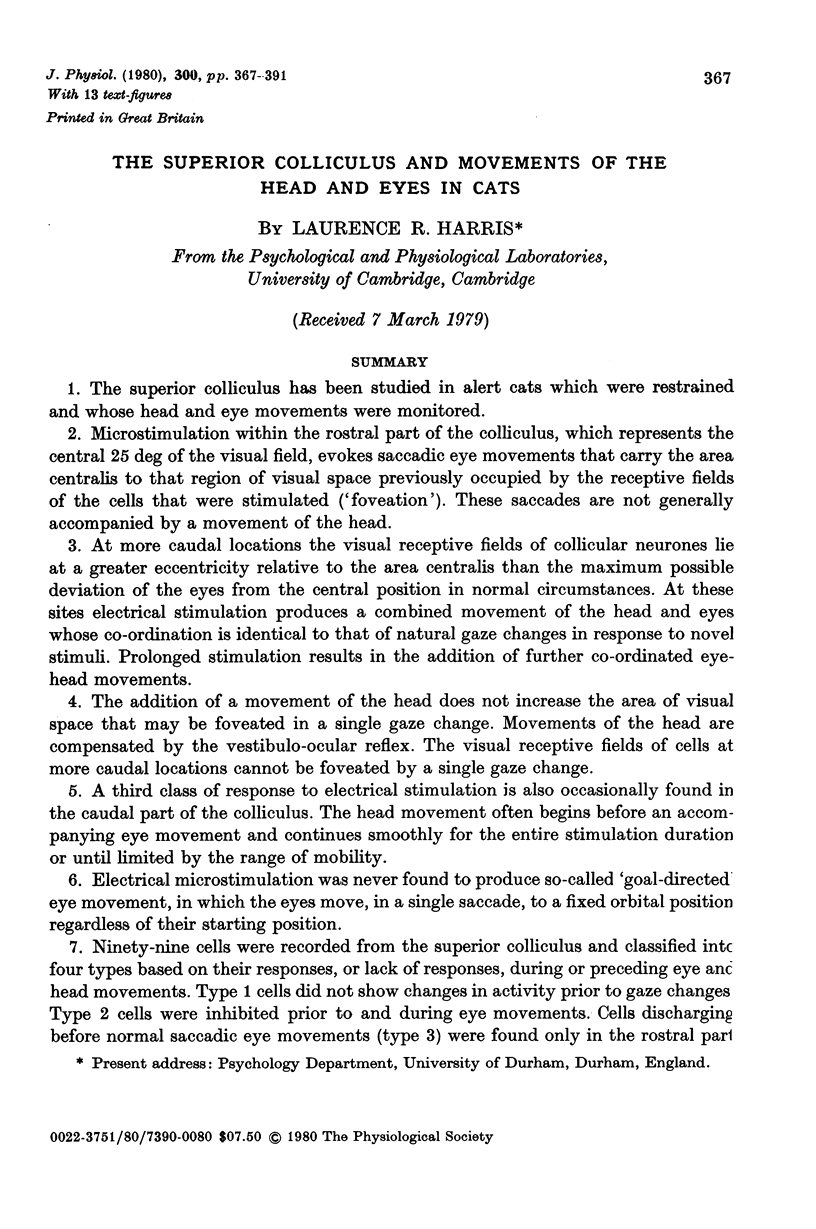
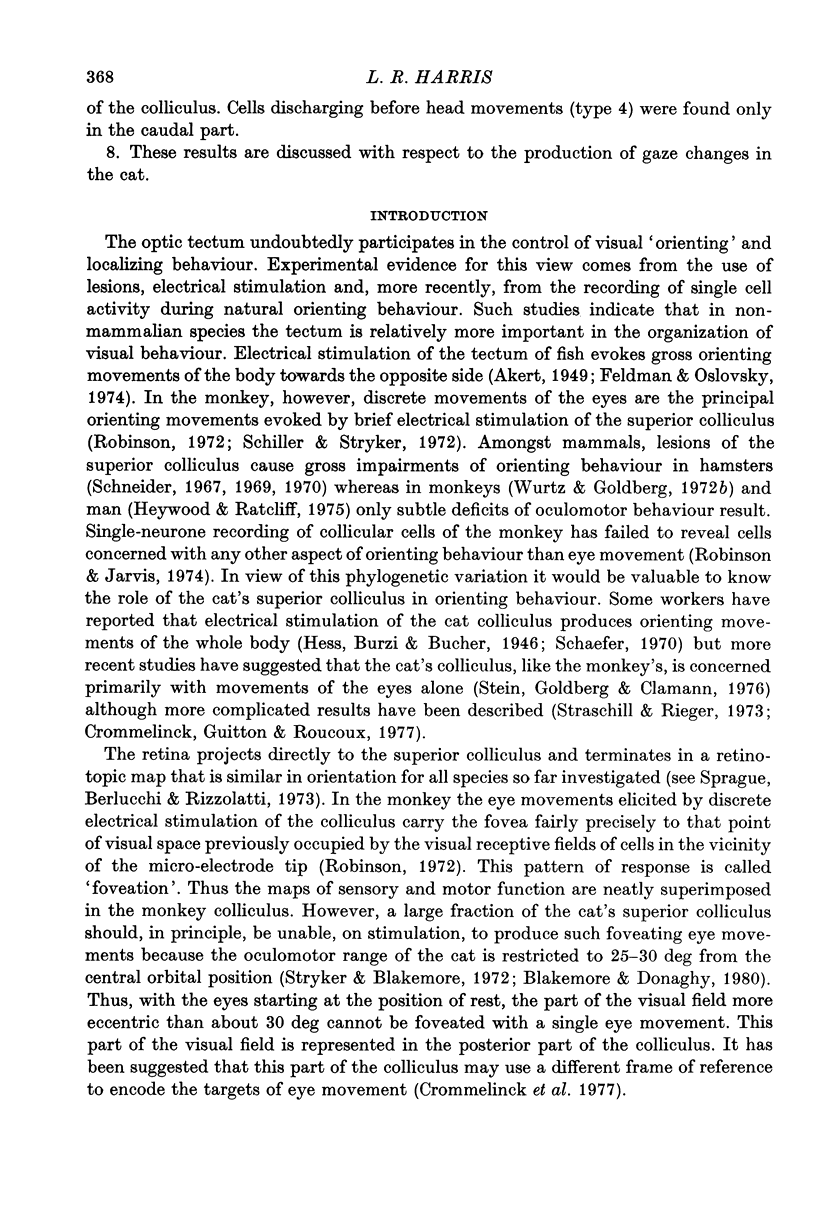
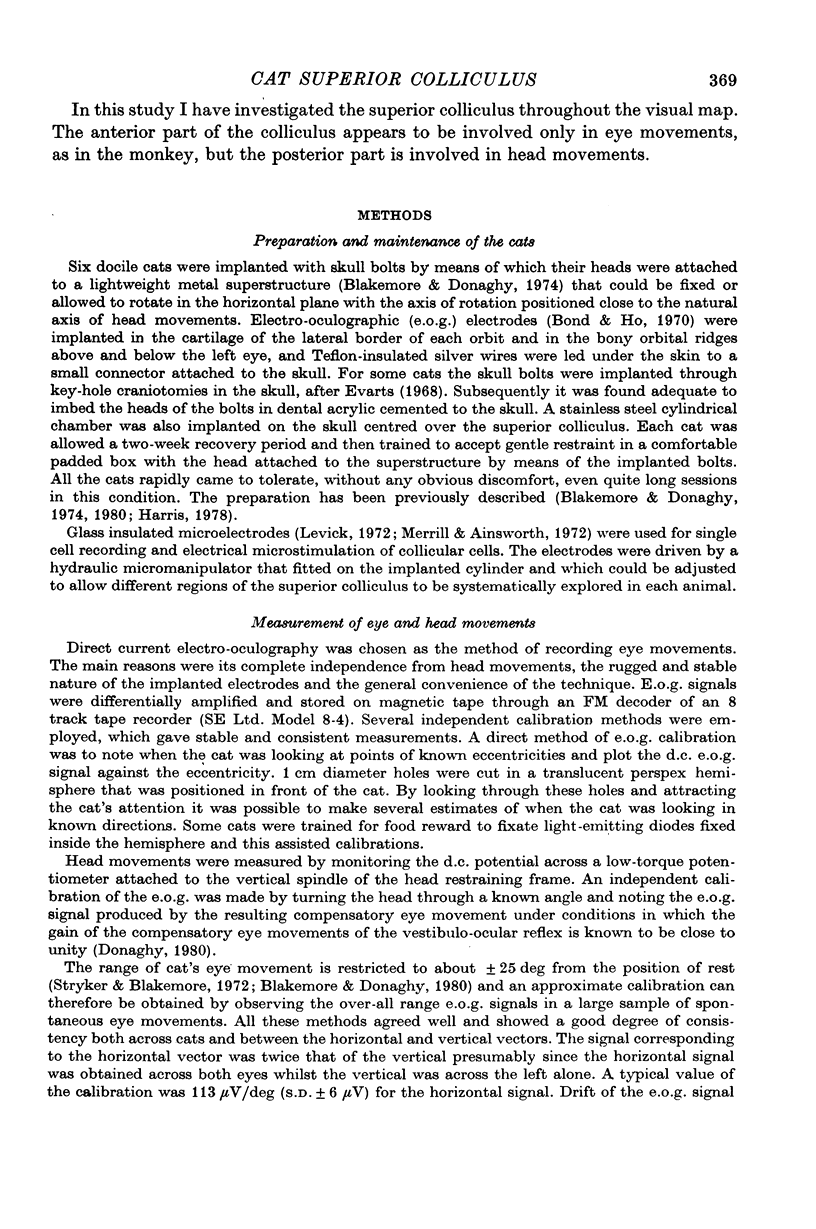
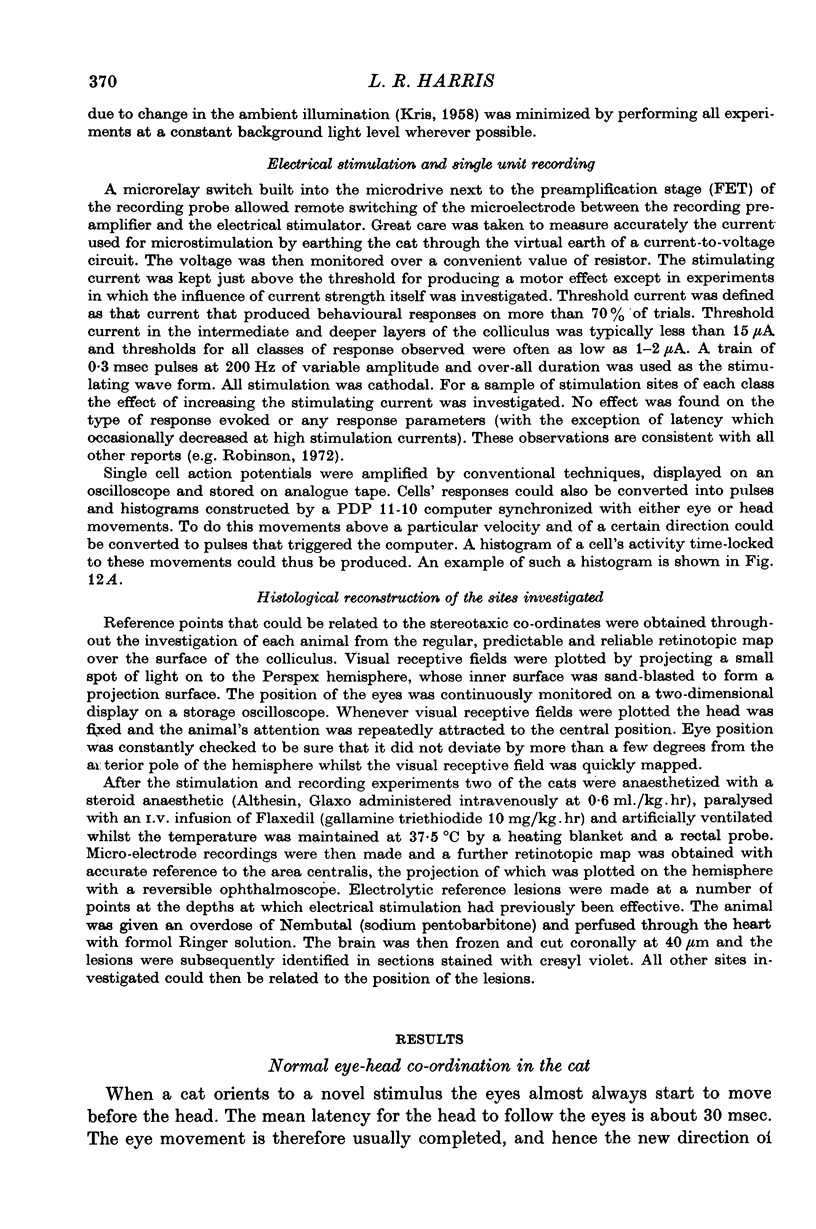
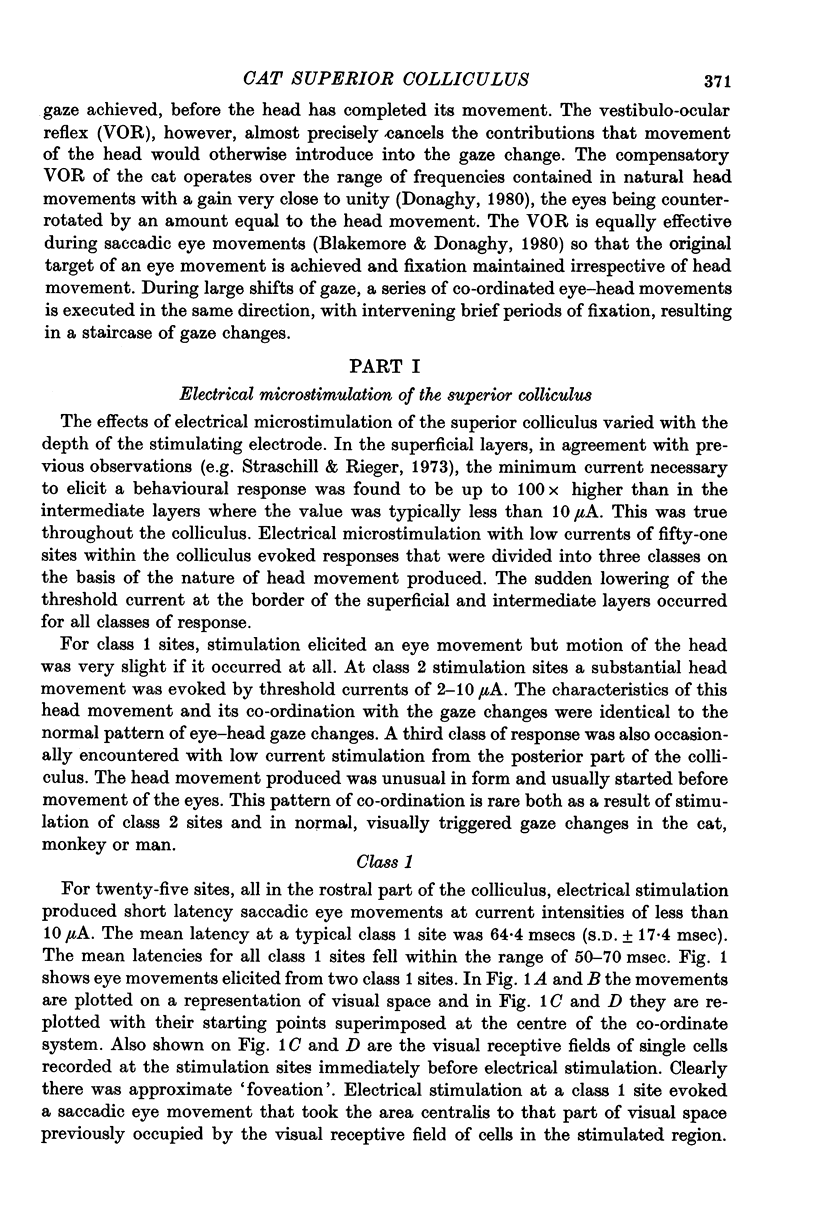
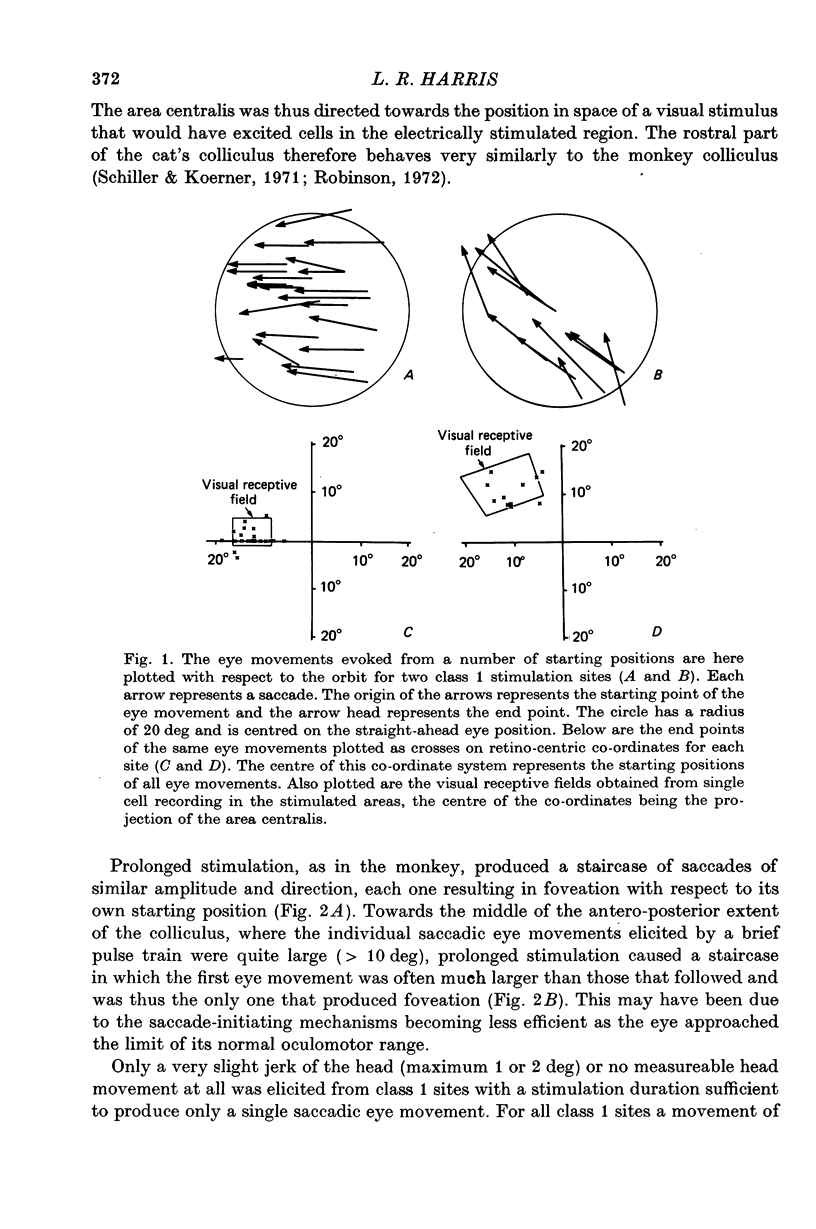
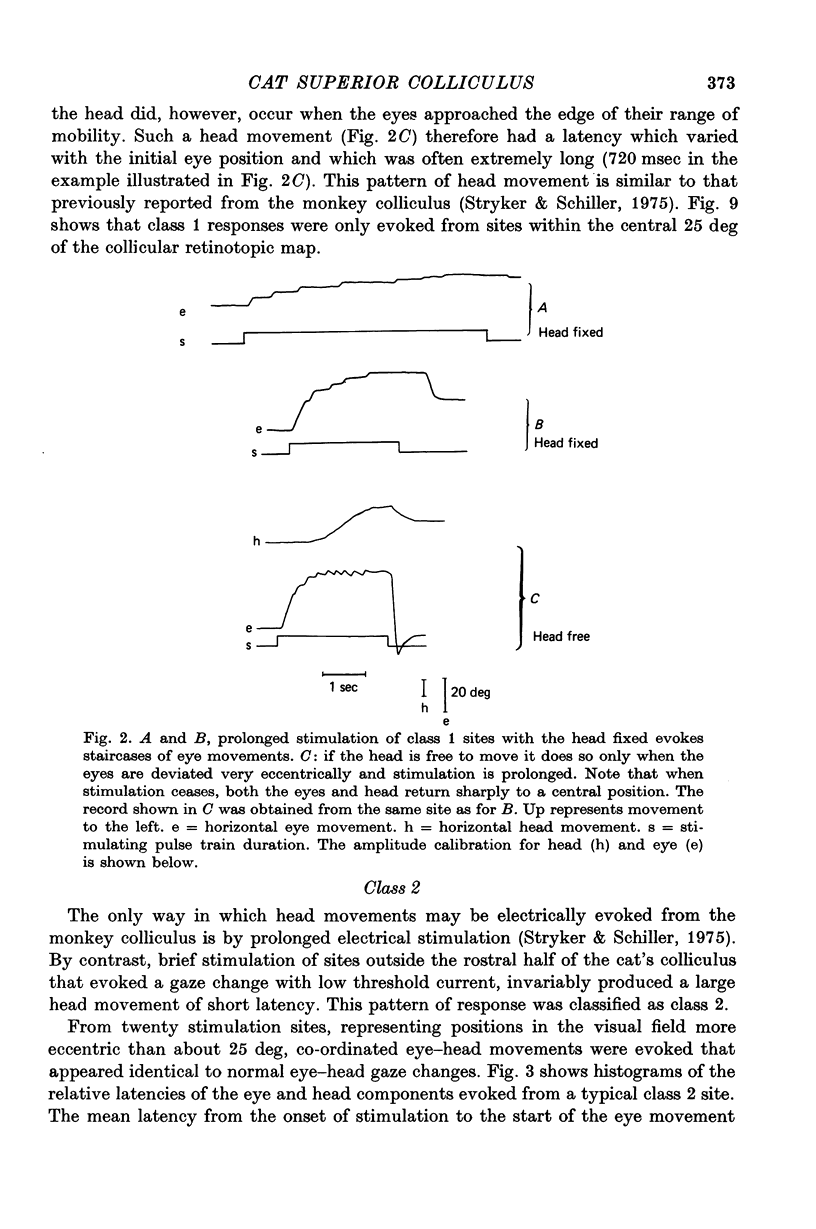
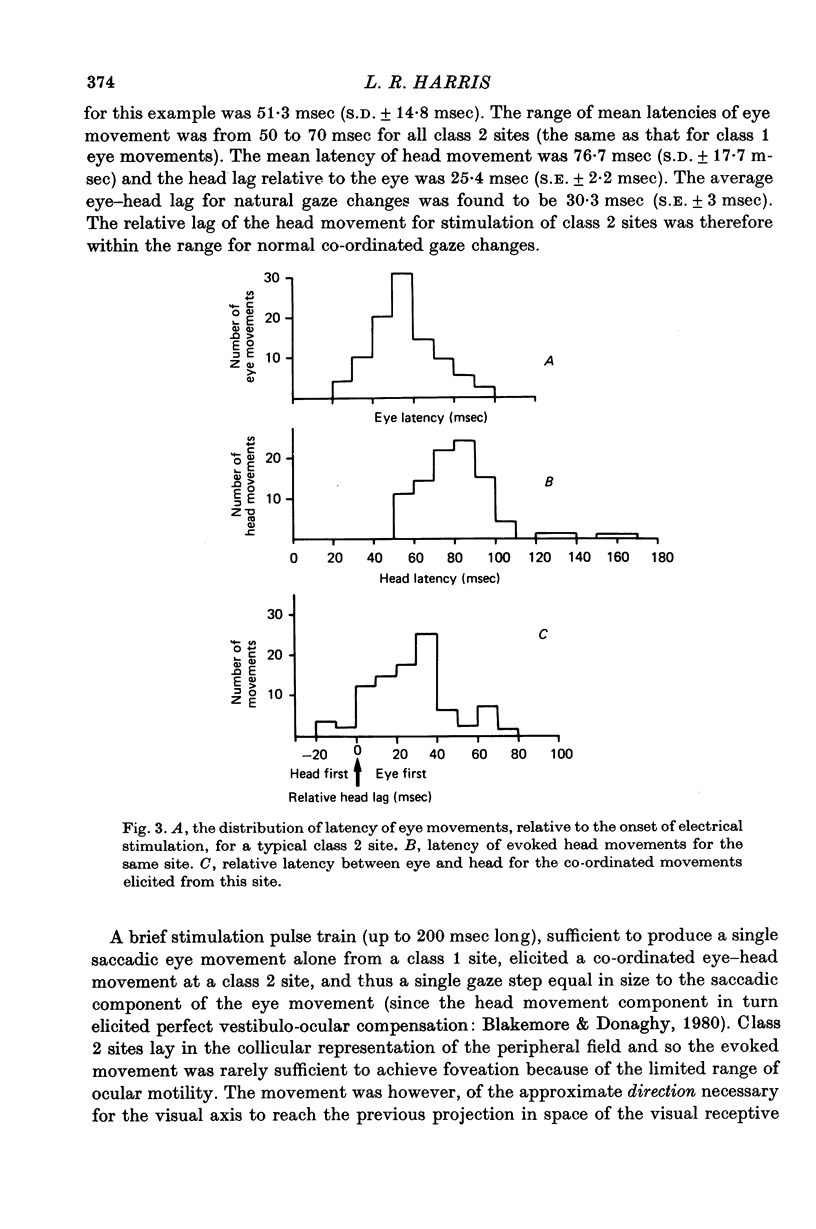
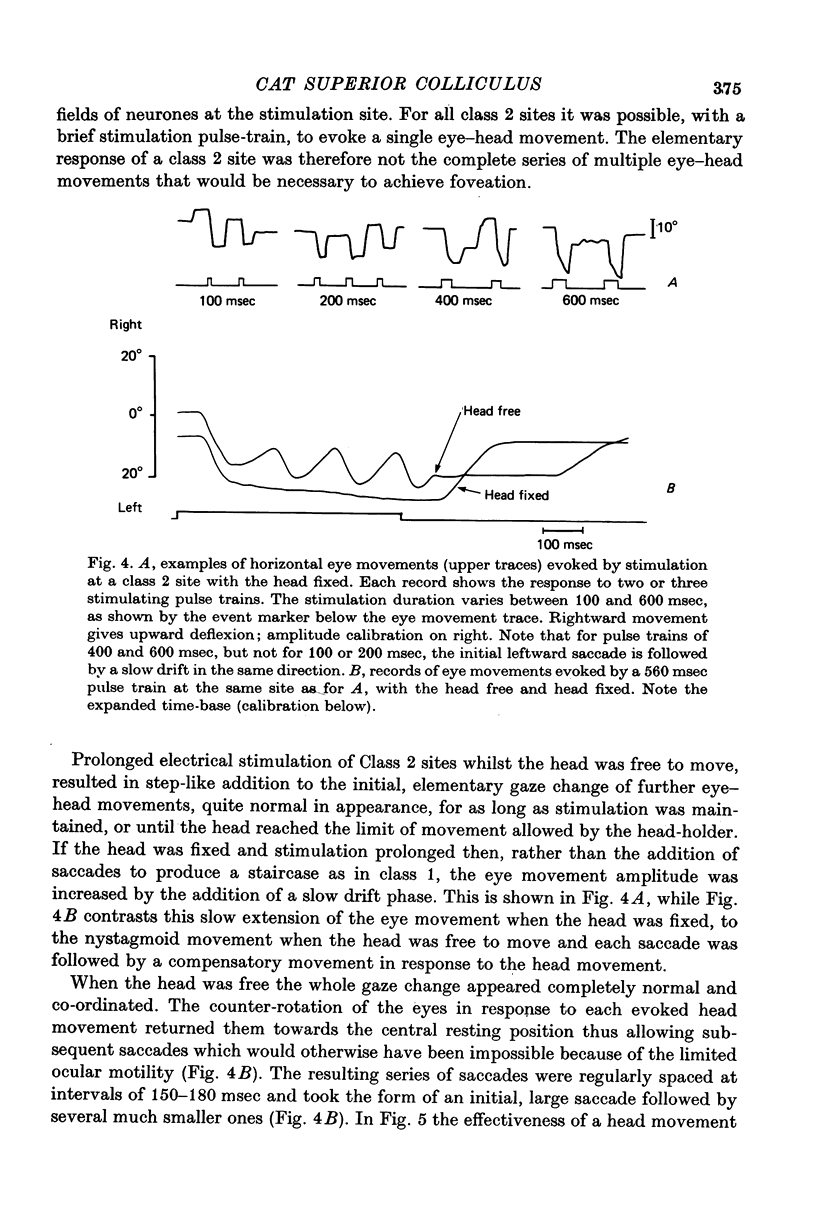
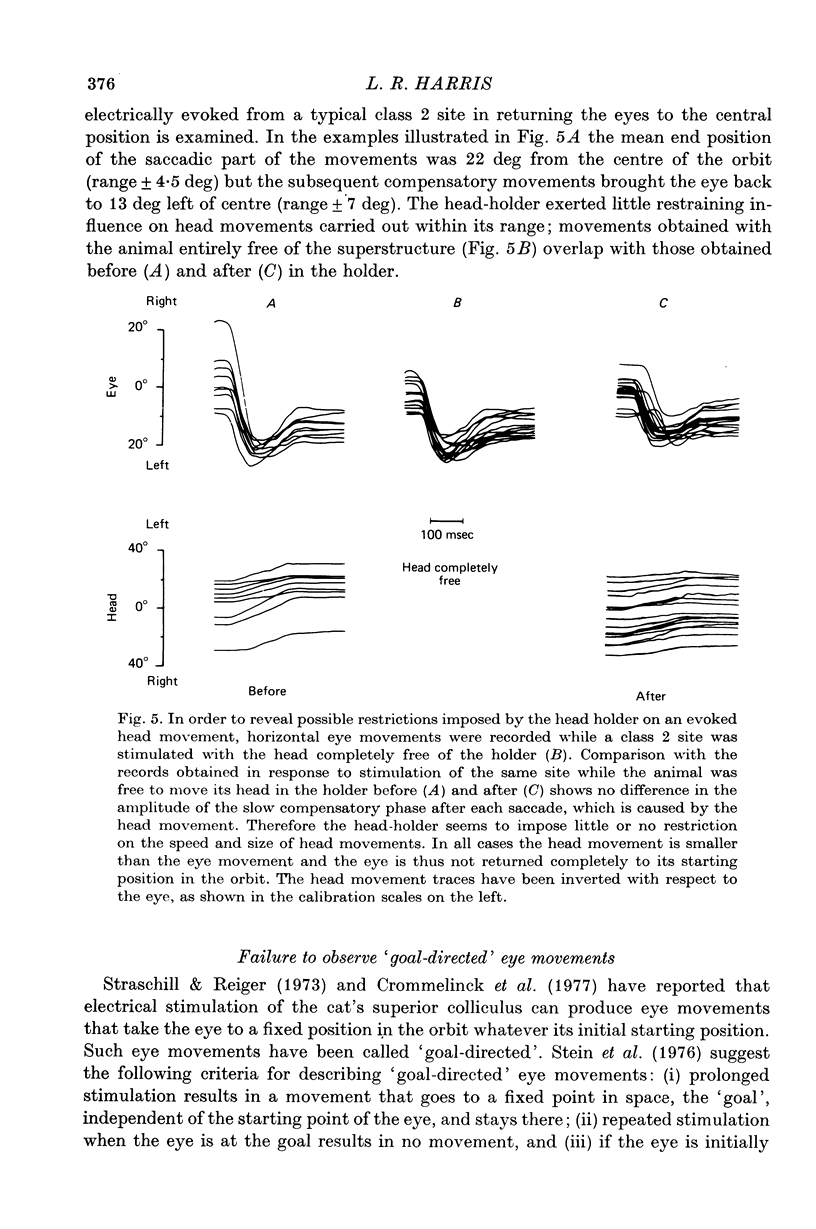
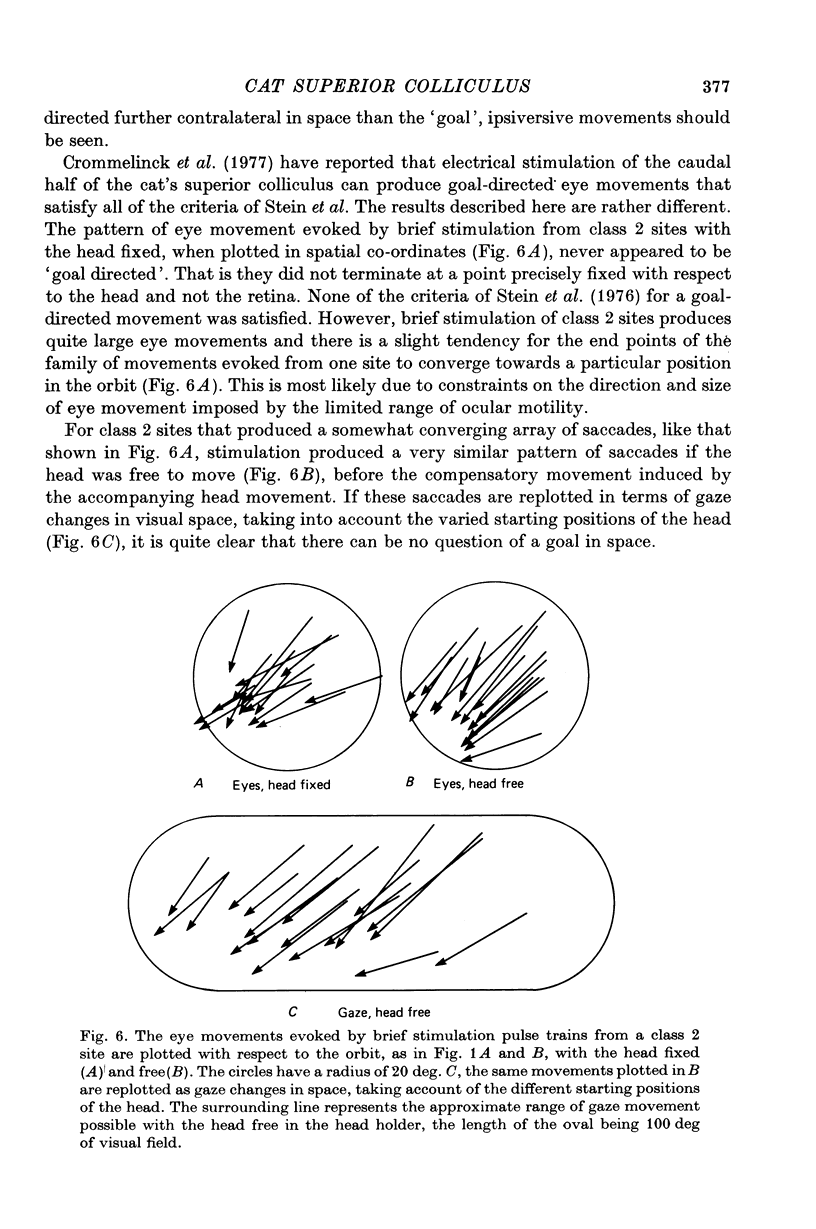
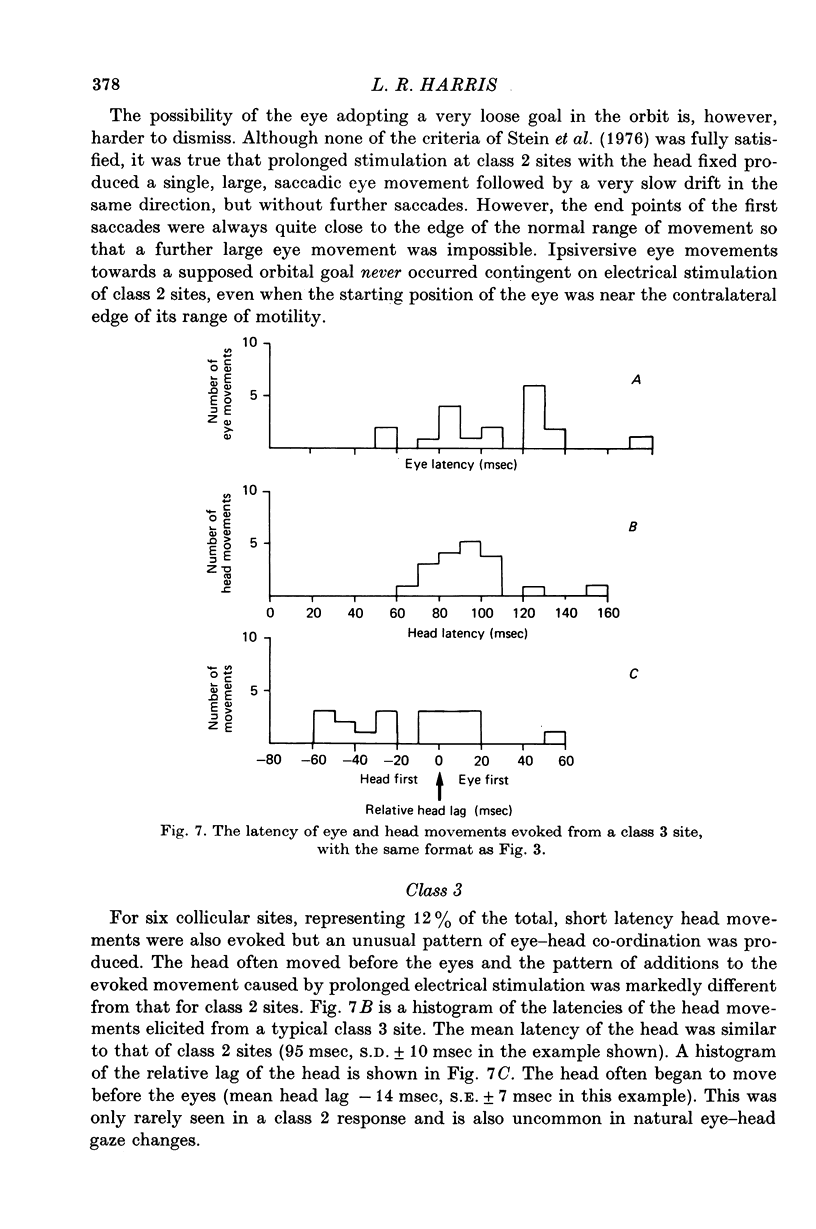
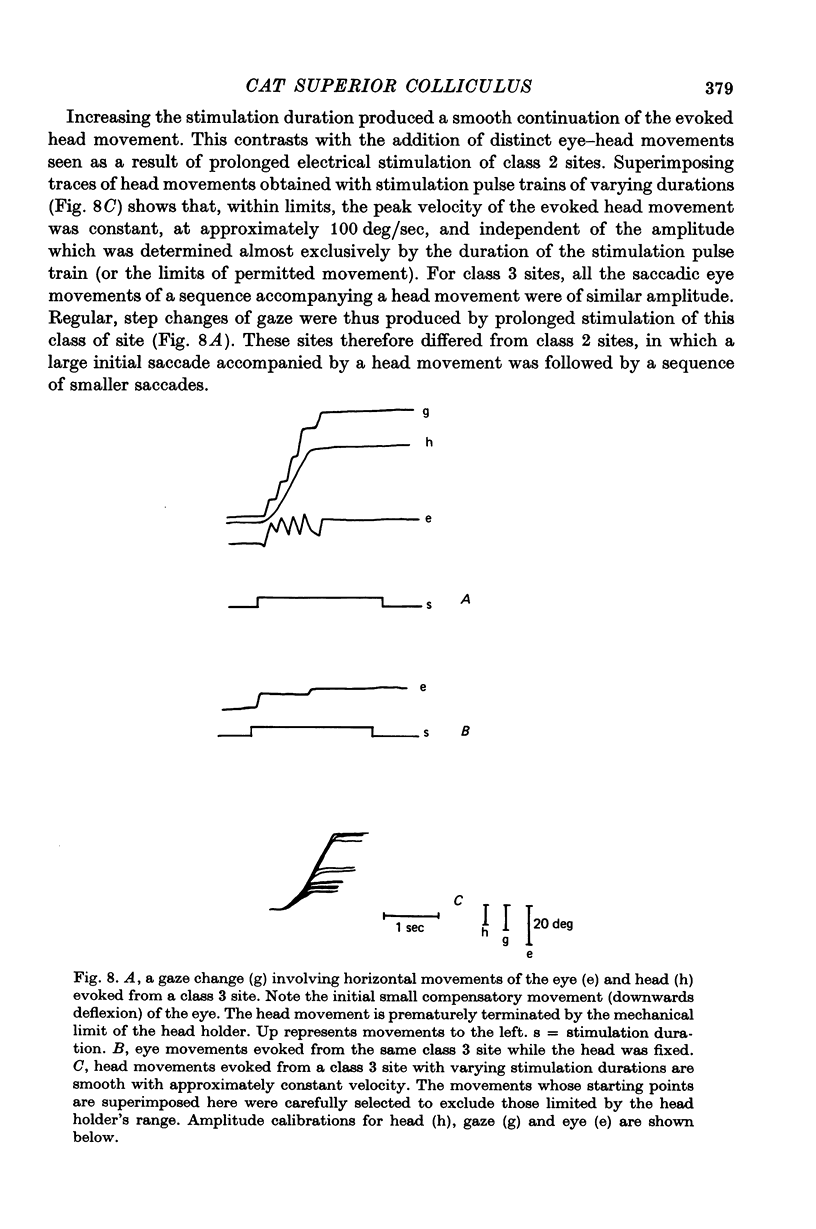
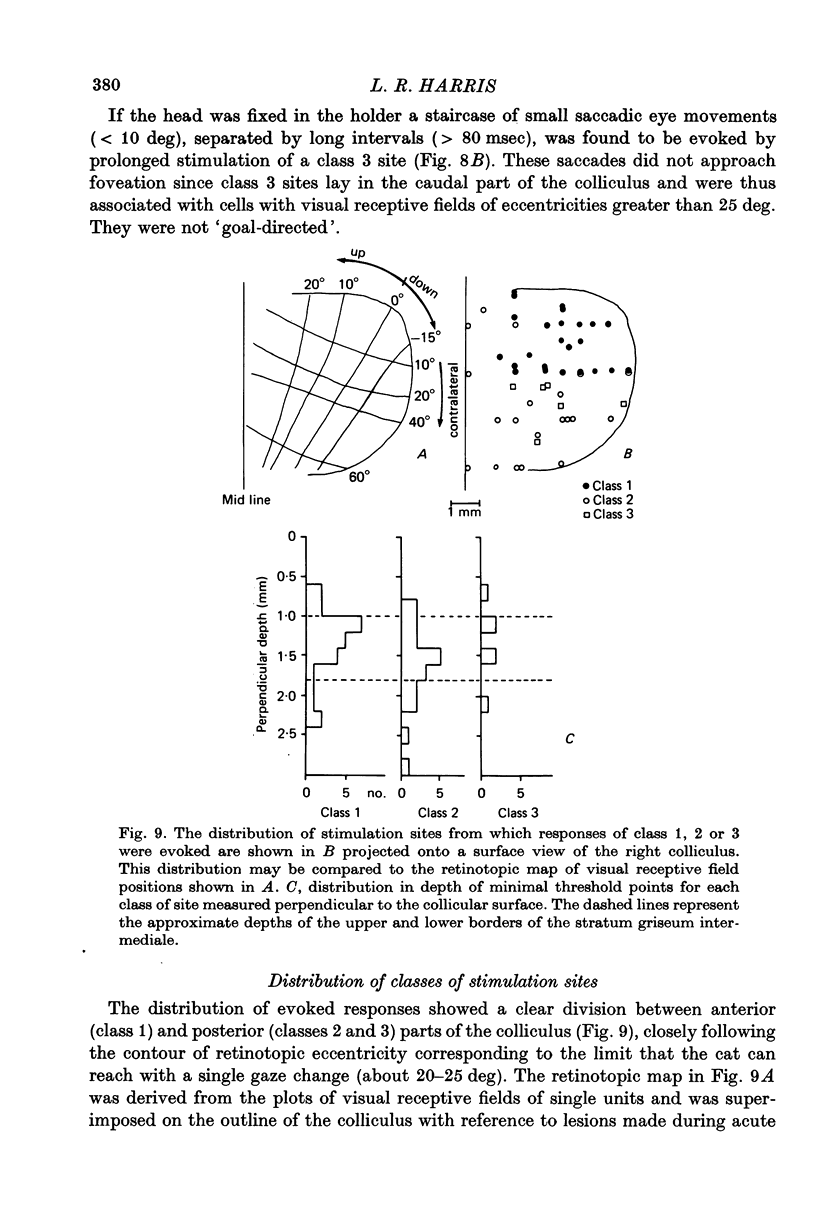
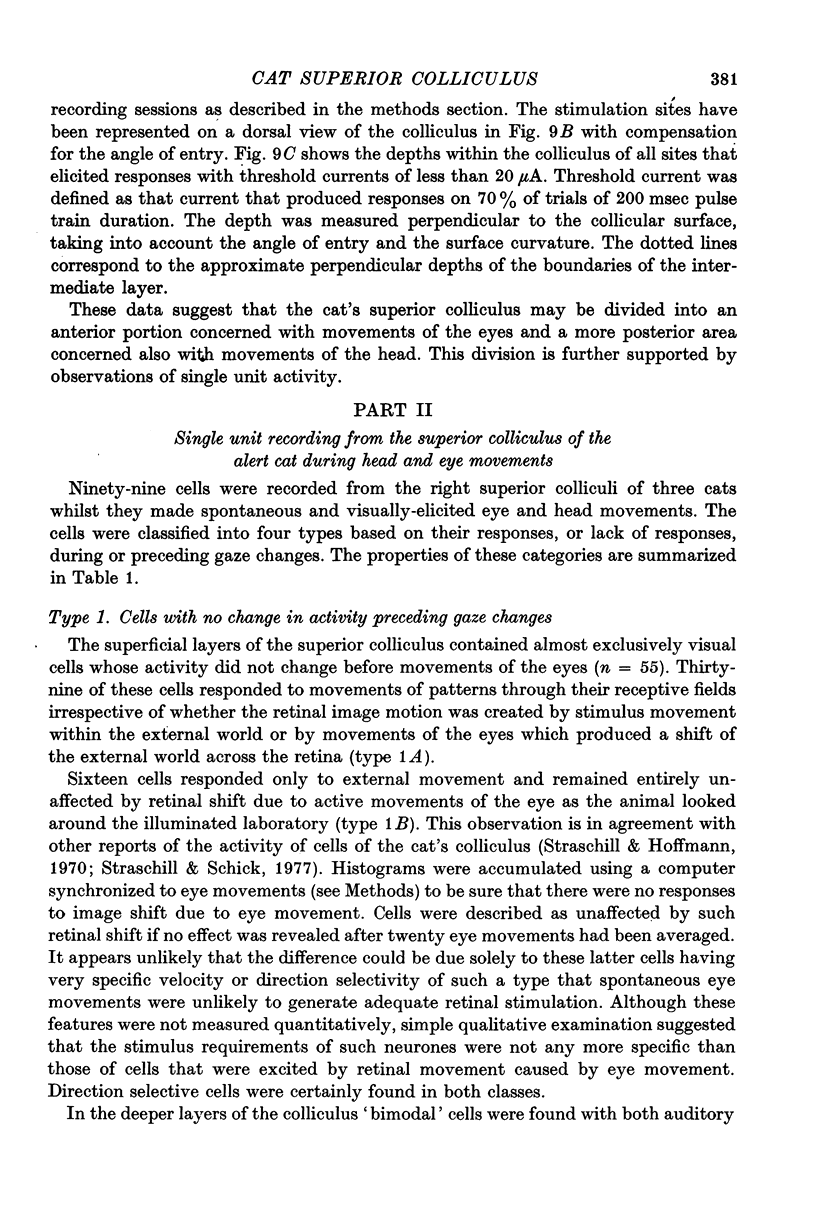
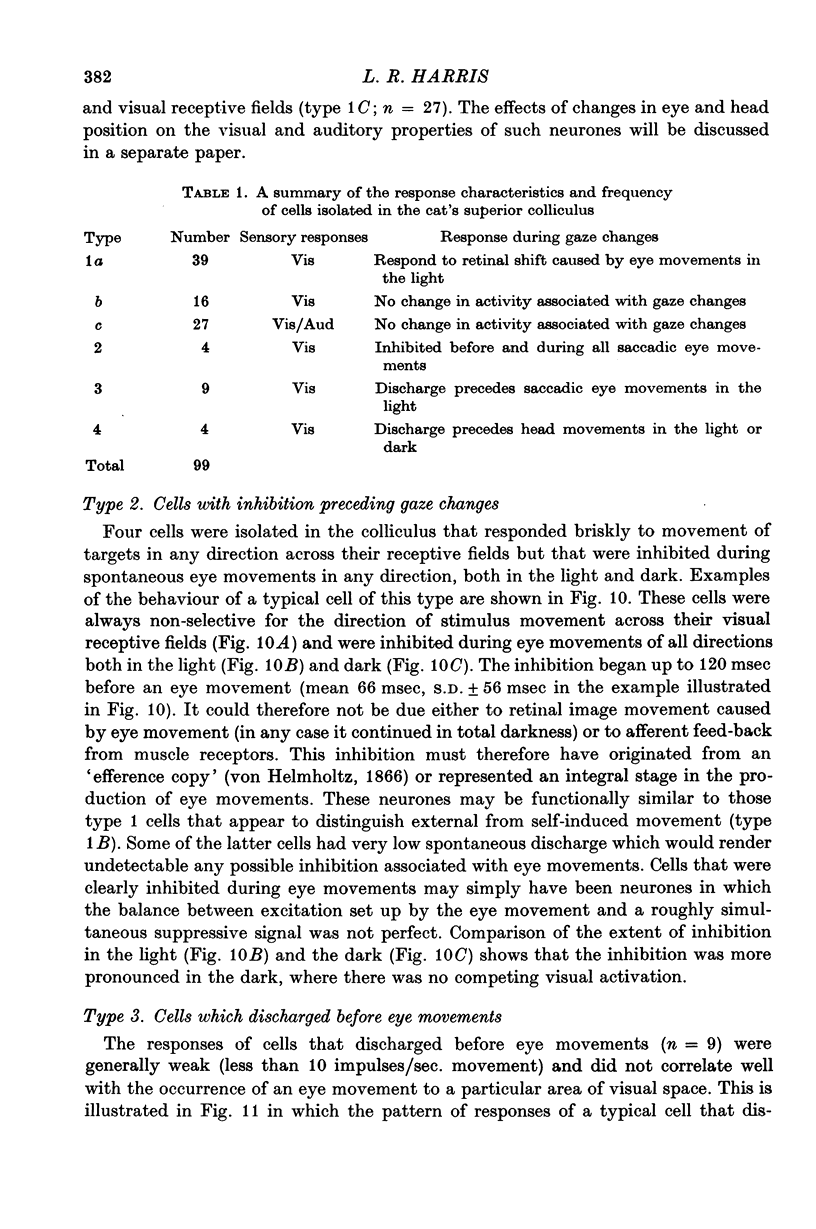
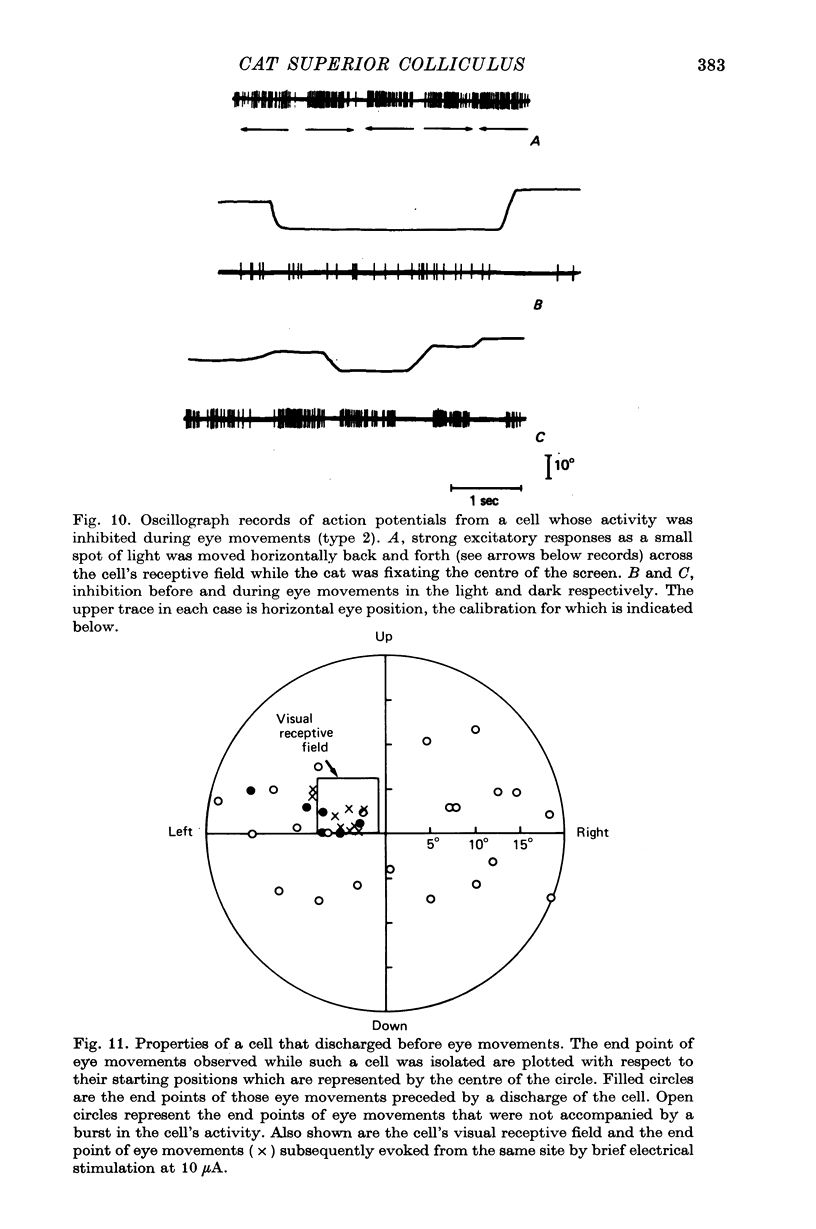
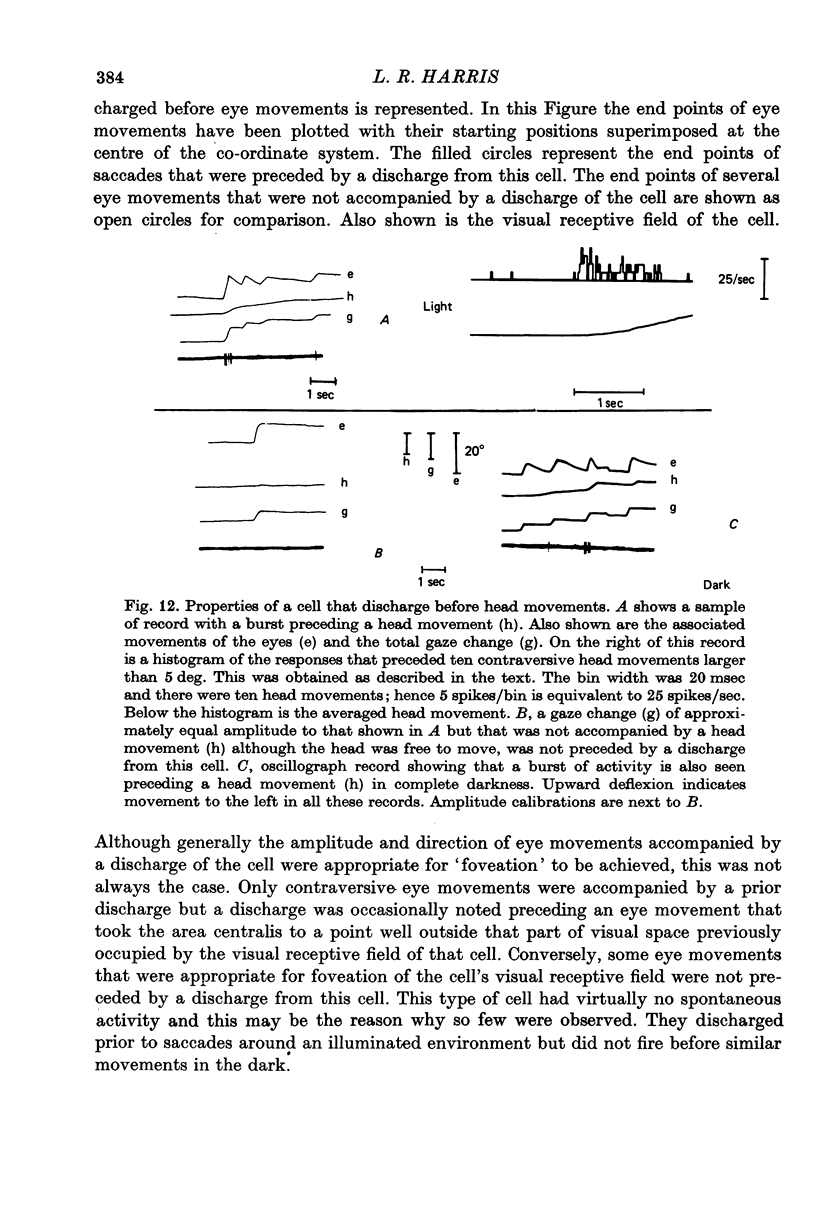
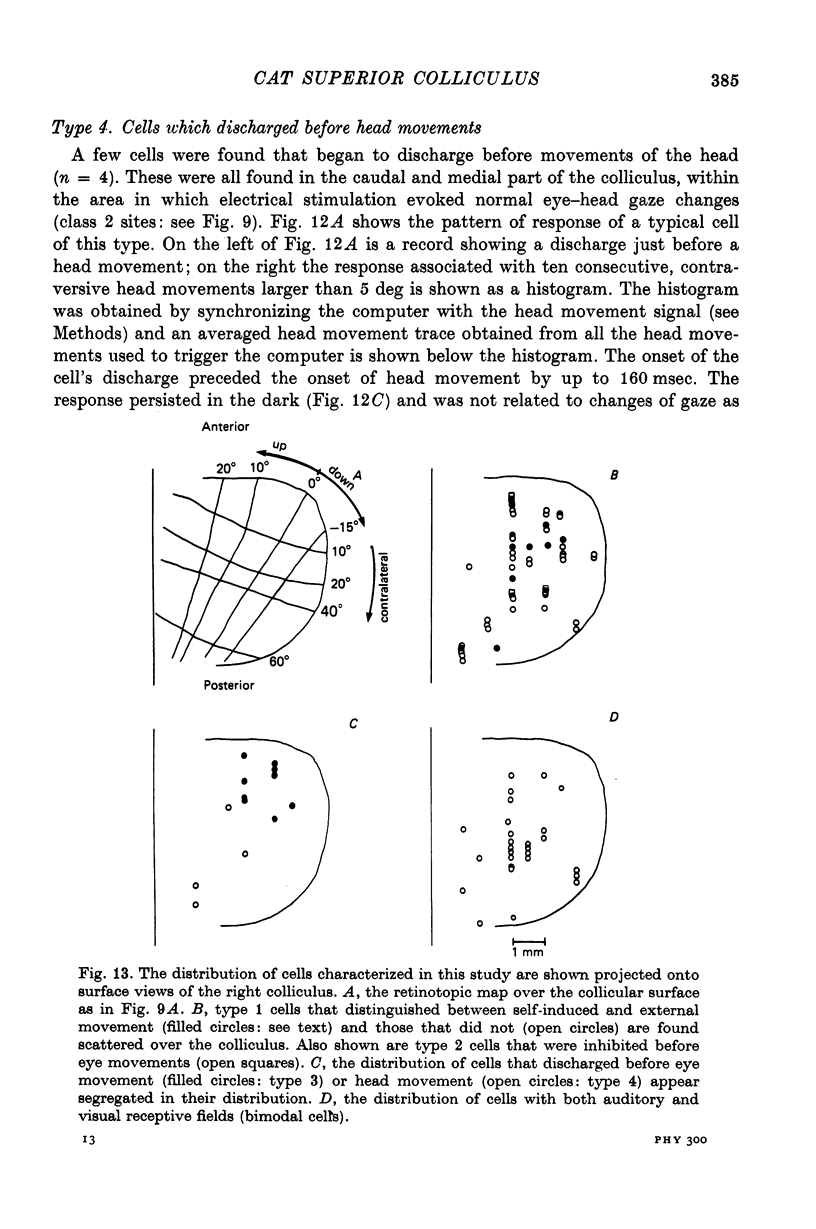
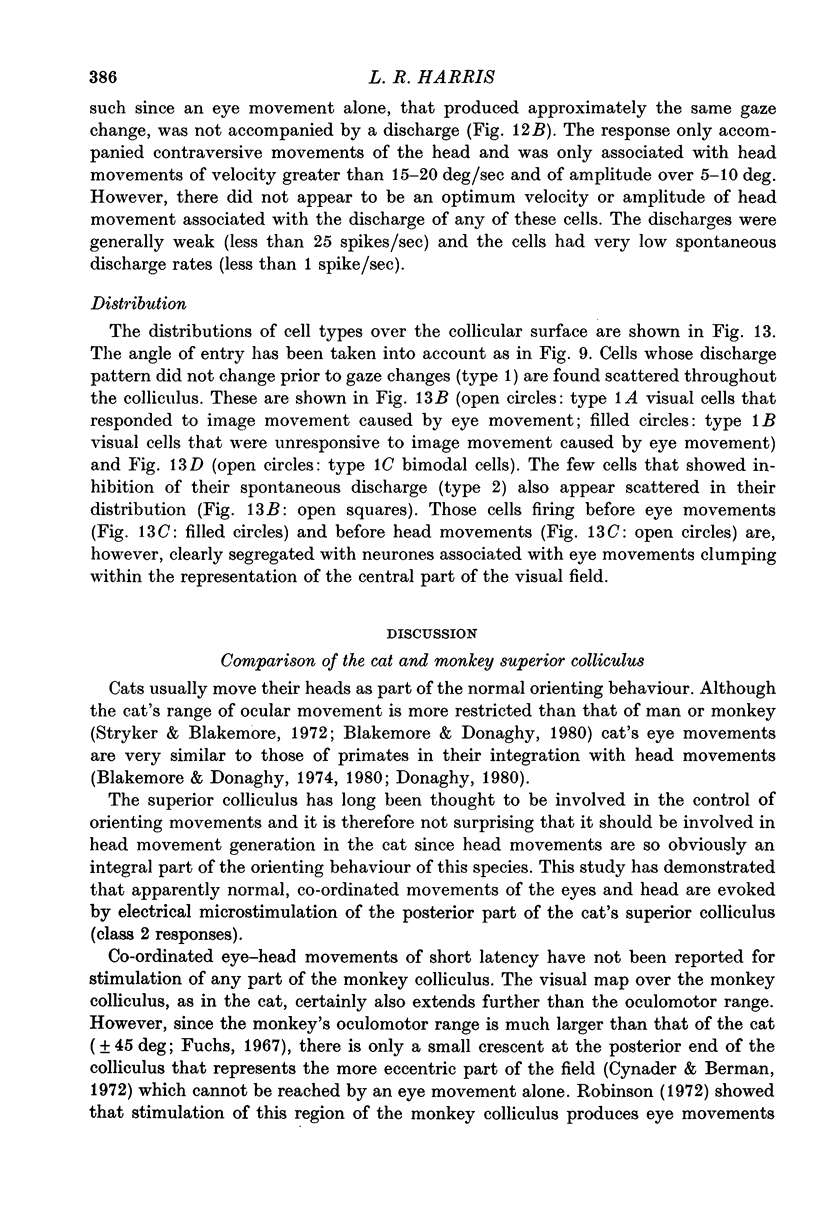
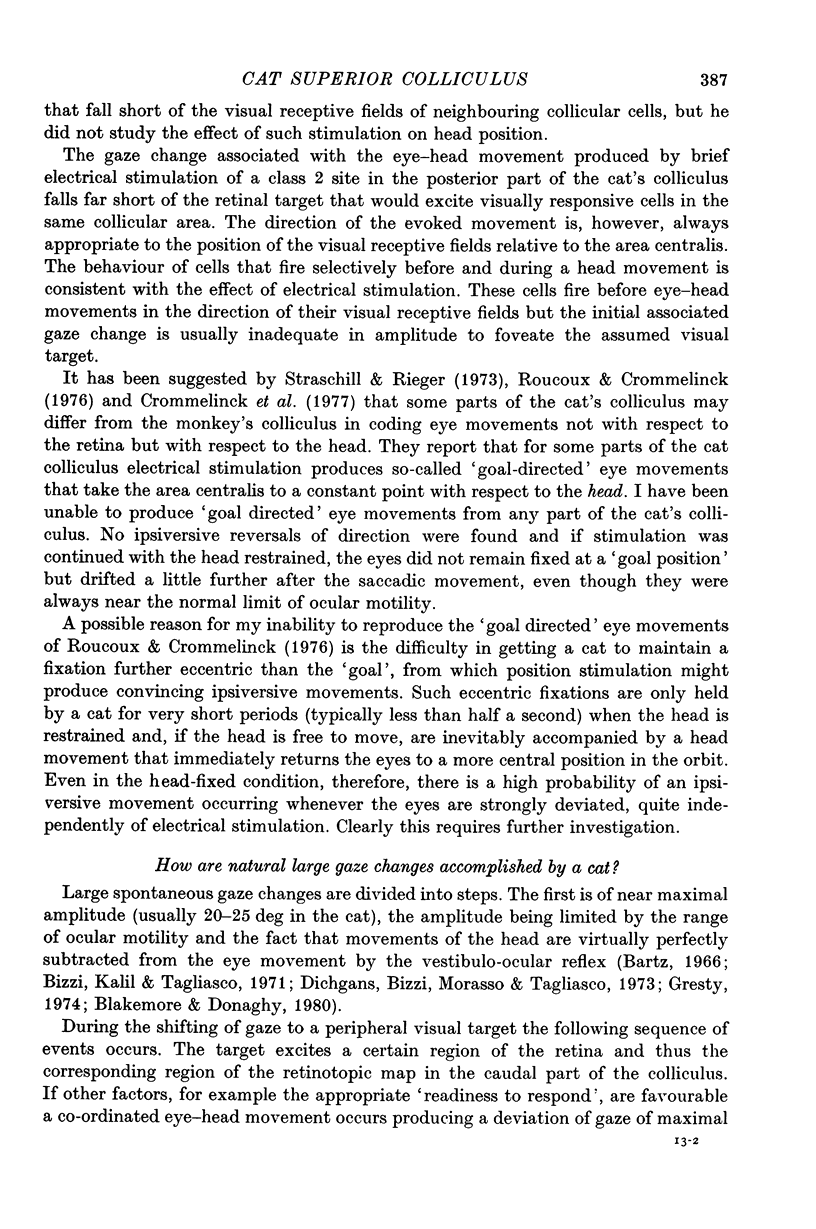
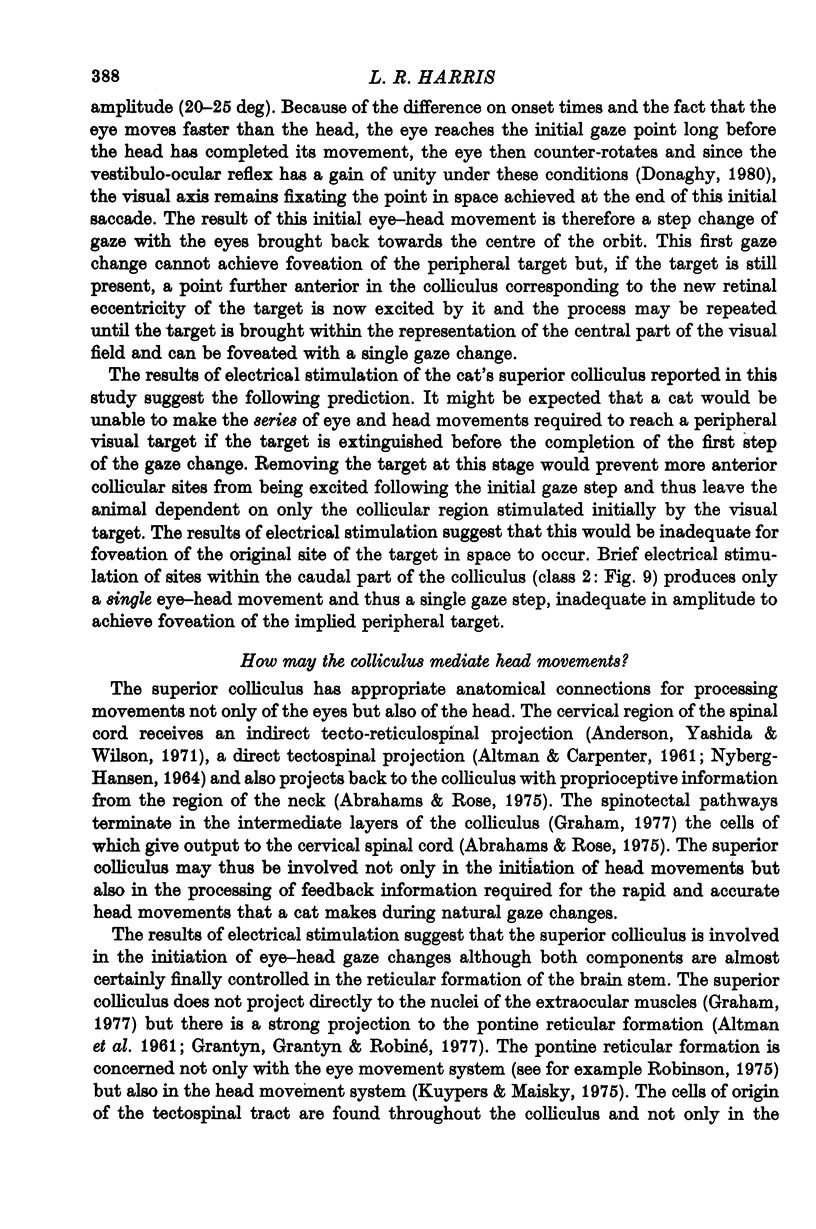
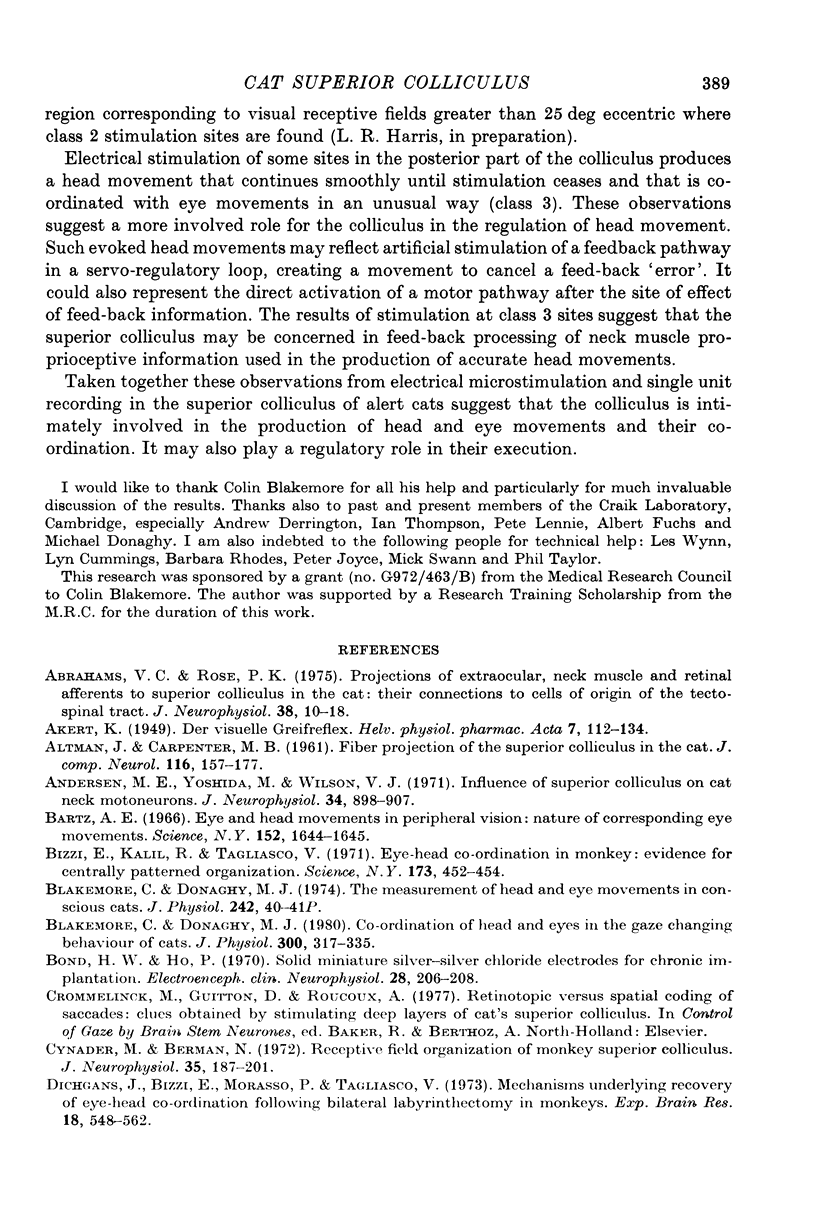
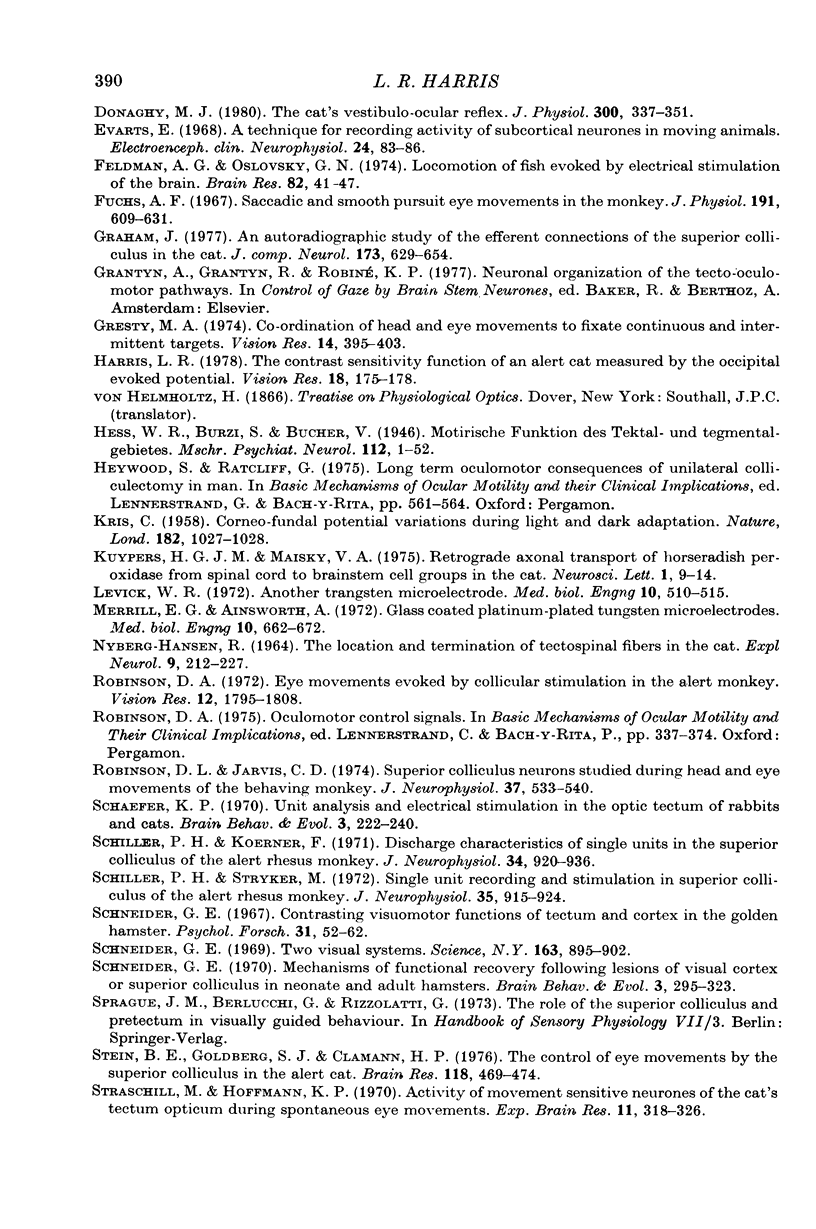
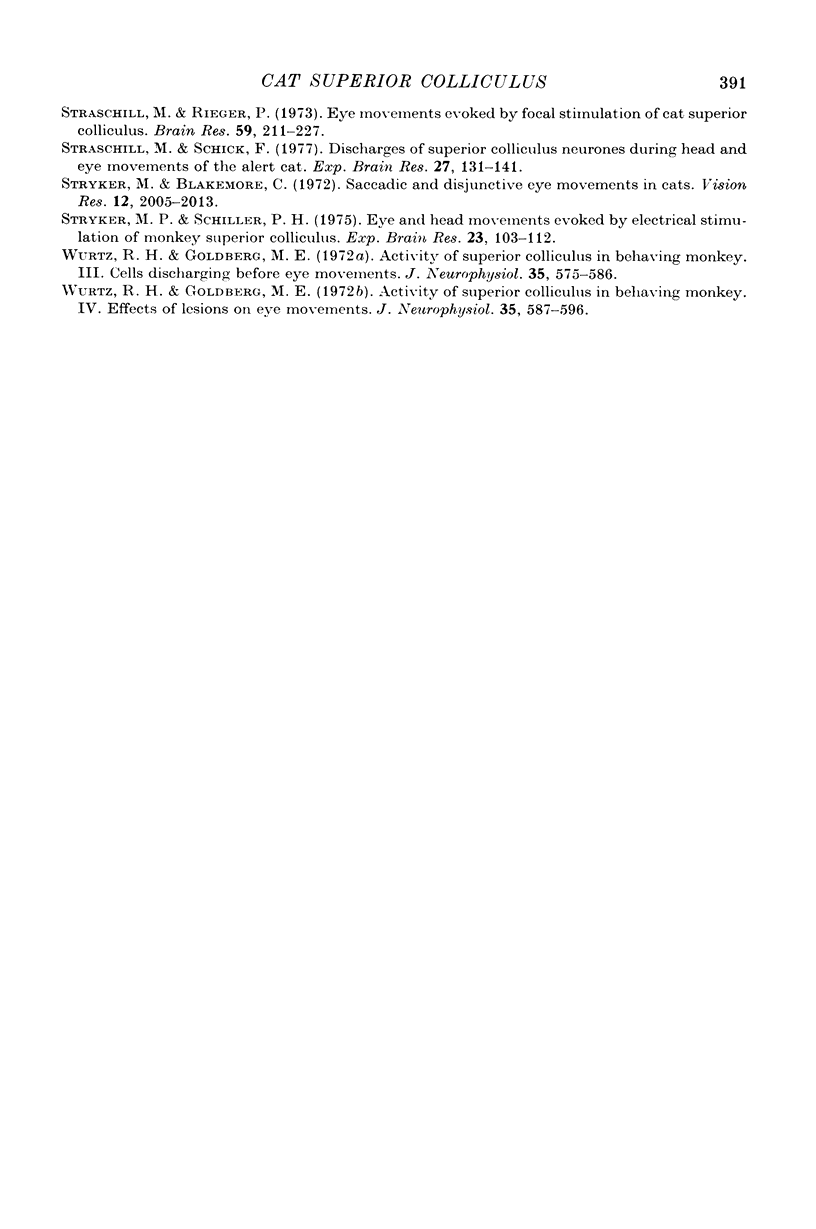
Selected References
These references are in PubMed. This may not be the complete list of references from this article.
- ALTMAN J., CARPENTER M. B. Fiber projections of the superior colliculus in the cat. J Comp Neurol. 1961 Apr;116:157–177. doi: 10.1002/cne.901160206. [DOI] [PubMed] [Google Scholar]
- Abrahams V. C., Rose P. K. Projections of extraocular, neck muscle, and retinal afferents to superior colliculus in the cat: their connections to cells of origin of tectospinal tract. J Neurophysiol. 1975 Jan;38(1):10–18. doi: 10.1152/jn.1975.38.1.10. [DOI] [PubMed] [Google Scholar]
- Anderson M. E., Yoshida M., Wilson V. J. Influence of superior colliculus on cat neck motoneurons. J Neurophysiol. 1971 Sep;34(5):898–907. doi: 10.1152/jn.1971.34.5.898. [DOI] [PubMed] [Google Scholar]
- Bartz A. E. Eye and head movements in peripheral vision: nature of compensatory eye movements. Science. 1966 Jun 17;152(3729):1644–1645. doi: 10.1126/science.152.3729.1644. [DOI] [PubMed] [Google Scholar]
- Bizzi E., Kalil R. E., Tagliasco V. Eye-head coordination in monkeys: evidence for centrally patterned organization. Science. 1971 Jul 30;173(3995):452–454. doi: 10.1126/science.173.3995.452. [DOI] [PubMed] [Google Scholar]
- Blakemore C., Donaghy M. J. Proceedings: The measurement of head and eye movements in conscious cats. J Physiol. 1974 Oct;242(2):40P–41P. [PubMed] [Google Scholar]
- Blakemore C., Donaghy M. Co-ordination of head and eyes in the gaze changing behaviour of cats. J Physiol. 1980 Mar;300:317–335. doi: 10.1113/jphysiol.1980.sp013164. [DOI] [PMC free article] [PubMed] [Google Scholar]
- Bond H. W., Ho P. Solid miniature silver-silver chloride electrodes for chronic implantation. Electroencephalogr Clin Neurophysiol. 1970 Feb;28(2):206–208. doi: 10.1016/0013-4694(70)90190-2. [DOI] [PubMed] [Google Scholar]
- Cynader M., Berman N. Receptive-field organization of monkey superior colliculus. J Neurophysiol. 1972 Mar;35(2):187–201. doi: 10.1152/jn.1972.35.2.187. [DOI] [PubMed] [Google Scholar]
- Dichgans J., Bizzi E., Morasso P., Tagliasco V. Mechanisms underlying recovery of eye-head coordination following bilateral labyrinthectomy in monkeys. Exp Brain Res. 1973 Dec 20;18(5):548–562. doi: 10.1007/BF00234137. [DOI] [PubMed] [Google Scholar]
- Donaghy M. The cat's vestibulo-ocular reflex. J Physiol. 1980 Mar;300:337–351. doi: 10.1113/jphysiol.1980.sp013165. [DOI] [PMC free article] [PubMed] [Google Scholar]
- Evarts E. V. A technique for recording activity of subcortical neurons in moving animals. Electroencephalogr Clin Neurophysiol. 1968 Jan;24(1):83–86. doi: 10.1016/0013-4694(68)90070-9. [DOI] [PubMed] [Google Scholar]
- Fuchs A. F. Saccadic and smooth pursuit eye movements in the monkey. J Physiol. 1967 Aug;191(3):609–631. doi: 10.1113/jphysiol.1967.sp008271. [DOI] [PMC free article] [PubMed] [Google Scholar]
- Graham J. An autoradiographic study of the efferent connections of the superior colliculus in the cat. J Comp Neurol. 1977 Jun 15;173(4):629–654. doi: 10.1002/cne.901730403. [DOI] [PubMed] [Google Scholar]
- Gresty M. A. Coordination of head and eye movements to fixate continuous and intermittent targets. Vision Res. 1974 Jun;14(6):395–403. doi: 10.1016/0042-6989(74)90238-7. [DOI] [PubMed] [Google Scholar]
- Harris L. R. Contrast sensitivity and acuity of a conscious cat measured by the occipital evoked potential. Vision Res. 1978;18(2):175–178. doi: 10.1016/0042-6989(78)90182-7. [DOI] [PubMed] [Google Scholar]
- KRIS C. Corneo-fundal potential variations during light and dark adaptation. Nature. 1958 Oct 11;182(4641):1027–1028. doi: 10.1038/1821027a0. [DOI] [PubMed] [Google Scholar]
- Kashin S. M., Feldman A. G., Orlovsky G. N. Locomotion of fish evoked by electrical stimulation of the brain. Brain Res. 1974 Dec 20;82(1):41–47. doi: 10.1016/0006-8993(74)90891-9. [DOI] [PubMed] [Google Scholar]
- Levick W. R. Another tungsten microelectrode. Med Biol Eng. 1972 Jul;10(4):510–515. doi: 10.1007/BF02474199. [DOI] [PubMed] [Google Scholar]
- Merrill E. G., Ainsworth A. Glass-coated platinum-plated tungsten microelectrodes. Med Biol Eng. 1972 Sep;10(5):662–672. doi: 10.1007/BF02476084. [DOI] [PubMed] [Google Scholar]
- NYBERG-HANSEN R. THE LOCATION AND TERMINATION OF TECTOSPINAL FIBERS IN THE CAT. Exp Neurol. 1964 Mar;9:212–227. doi: 10.1016/0014-4886(64)90018-4. [DOI] [PubMed] [Google Scholar]
- Robinson D. A. Eye movements evoked by collicular stimulation in the alert monkey. Vision Res. 1972 Nov;12(11):1795–1808. doi: 10.1016/0042-6989(72)90070-3. [DOI] [PubMed] [Google Scholar]
- Robinson D. L., Jarvis C. D. Superior colliculus neurons studied during head and eye movements of the behaving monkey. J Neurophysiol. 1974 May;37(3):533–540. doi: 10.1152/jn.1974.37.3.533. [DOI] [PubMed] [Google Scholar]
- Schaefer K. P. Unit analysis and electrical stimulation in the optic tectum of rabbits and cats. Brain Behav Evol. 1970;3(1):222–240. doi: 10.1159/000125475. [DOI] [PubMed] [Google Scholar]
- Schiller P. H., Koerner F. Discharge characteristics of single units in superior colliculus of the alert rhesus monkey. J Neurophysiol. 1971 Sep;34(5):920–936. doi: 10.1152/jn.1971.34.5.920. [DOI] [PubMed] [Google Scholar]
- Schiller P. H., Stryker M. Single-unit recording and stimulation in superior colliculus of the alert rhesus monkey. J Neurophysiol. 1972 Nov;35(6):915–924. doi: 10.1152/jn.1972.35.6.915. [DOI] [PubMed] [Google Scholar]
- Schneider G. E. Contrasting visuomotor functions of tectum and cortex in the golden hamster. Psychol Forsch. 1967;31(1):52–62. doi: 10.1007/BF00422386. [DOI] [PubMed] [Google Scholar]
- Schneider G. E. Mechanisms of functional recovery following lesions of visual cortex or superior colliculus in neonate and adult hamsters. Brain Behav Evol. 1970;3(1):295–323. doi: 10.1159/000125479. [DOI] [PubMed] [Google Scholar]
- Schneider G. E. Two visual systems. Science. 1969 Feb 28;163(3870):895–902. doi: 10.1126/science.163.3870.895. [DOI] [PubMed] [Google Scholar]
- Stein B. E., Goldberg S. J., Clamann H. P. The control of eye movements by the superior colliculus in the alert cat. Brain Res. 1976 Dec 24;118(3):469–474. doi: 10.1016/0006-8993(76)90314-0. [DOI] [PubMed] [Google Scholar]
- Straschill M., Hoffmann K. P. Activity of movement sensitive neurons of the cat's tectum opticum during spontaneous eye movements. Exp Brain Res. 1970;11(3):318–326. doi: 10.1007/BF01474390. [DOI] [PubMed] [Google Scholar]
- Straschill M., Rieger P. Eye movements evoked by focal stimulation of the cat's superior colliculus. Brain Res. 1973 Sep 14;59:211–227. doi: 10.1016/0006-8993(73)90262-x. [DOI] [PubMed] [Google Scholar]
- Straschill M., Schick F. Discharges of superior colliculus neurons during head and eye movements of the alert cat. Exp Brain Res. 1977 Feb 16;27(2):131–141. doi: 10.1007/BF00237694. [DOI] [PubMed] [Google Scholar]
- Stryker M. P., Schiller P. H. Eye and head movements evoked by electrical stimulation of monkey superior colliculus. Exp Brain Res. 1975 Jul 11;23(1):103–112. doi: 10.1007/BF00238733. [DOI] [PubMed] [Google Scholar]
- Stryker M., Blakemore C. Saccadic and disjunctive eye movements in cats. Vision Res. 1972 Dec;12(12):2005–2013. doi: 10.1016/0042-6989(72)90054-5. [DOI] [PubMed] [Google Scholar]
- Wurtz R. H., Goldberg M. E. Activity of superior colliculus in behaving monkey. 3. Cells discharging before eye movements. J Neurophysiol. 1972 Jul;35(4):575–586. doi: 10.1152/jn.1972.35.4.575. [DOI] [PubMed] [Google Scholar]
- Wurtz R. H., Goldberg M. E. Activity of superior colliculus in behaving monkey. IV. Effects of lesions on eye movements. J Neurophysiol. 1972 Jul;35(4):587–596. doi: 10.1152/jn.1972.35.4.587. [DOI] [PubMed] [Google Scholar]


